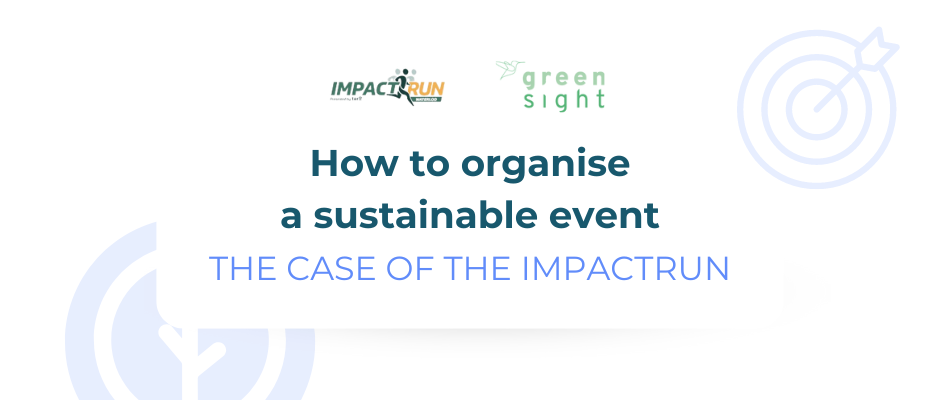How to organise a sustainable event
The case of the IMPACTRUN by Tero
Reading time: 5-6 minutes
Reading time: 5-6 minutes

Organising events can significantly impact the environment through greenhouse gas emissions, waste, and disruptions to local biodiversity. Recognising these challenges, Tero created IMPACTRUN to bring together professionals working in sustainability or aiming for a more sustainable system, regardless of their experience level. In this article, you will discover how to organise a sustainable event following the case of the IMPACTRUN.
To achieve this most consciously, they partnered with Tapio to calculate the event’s carbon footprint and organised workshops to reflect on how Tero can make this event more sustainable. Key contributors include Pauline Lavagna from Green Sight, an eco-responsible consultant for events and artists, and Pascaline du Bus, a carbon expert at Tapio.
A crucial part of organising sustainable events is finding the right sponsors. Through a governance workshop, Sportero and Tapio identified the following factors for selecting and prioritising partners:
Discover the full criteria here.
Effective communication is essential to avoid greenwashing. With Maxime Van Der Meerschen, Co-Founder of GiveActions and Clémentine Muschs, Marketing Manager at Sportero, we organised a workshop to discuss this. We identified the impact page for their website as a key to refer to in all communications, including the following sections to build credibility:
Check out IMPACTRUN’s impact page.
To identify how to reduce the event’s impact, we decided to involve Pauline Lavagna from Green Sight in the reflection, who, thanks to her years of experience, could identify the following areas to work on.
Transport often represents one of the most considerable emission sources for events. It’s complex to reduce since it largely depends on the goodwill of guests, but event organisers can adopt a series of practices to facilitate the use of eco-friendly alternatives.
In this case, public transport does not directly reach the Tero Eventhouse Waterloo. Here are some strategies to encourage alternatives to cars:
Additionally, event organisers can dissuade parking by imposing additional fees or restricting parking lots to car-sharing only.
Finally, here’s a tip from Pauline. In event communications, always propose the most eco-responsible travel option first, ending with the least sustainable (e.g. bike, train, carpooling, car).
Like mobility, energy can quickly become one of the most impactful categories in a carbon report. Especially for events in locations that don’t have an energy infrastructure, they sometimes use generators fed by fuel.
The IMPACTRUN will be held at Tero Eventhouse Waterloo, which represents a significant advantage on this topic due to the existing energy infrastructure. In this case, it’s essential to look at the energy provider (whether it’s a green provider or not).
The installation of solar panels in the months before the event will help reduce energy-related emissions even more, so the event will rely partly on the energy grid and solar panels.
The key to reducing the impact of food during events is the following:
In the case of IMPACTRUN, Tero already emphasises local and seasonal sourcing, which involves getting produce from a local farm (Ferme de Rabanisse). To reduce environmental impact even further, they can:
Waste is an impactful emission category for an event, but it also impacts other environmental factors such as biodiversity and soil health.
While some might argue that the most sustainable event is the one that doesn’t take place, studies suggest otherwise. Eco-conscious festivals can lower an individual’s daily carbon footprint through shared services and sustainable practices, such as composting toilets, vegetarian or vegan meals, and taking shorter showers. Pauline Lavagna adds, “It’s important that these events are local to avoid the impact of travelling.”
The social and cultural value of festivals cannot be ignored. Pauline emphasizes, “We shouldn’t overlook the well-being that comes from being together at an event, especially one that promotes eco-friendly practices. Such events can demonstrate to people that change is within reach and encourage them to adopt new sustainable habits.”
Pauline Lavagna, through Greensight, helps event organizers and artists transition to more sustainable practices. Her journey began in 2015 when she managed hospitality for a new music festival and transitioned to helping it become more sustainable. This experience ignited her passion for ecological transition, leading her to focus entirely on reducing the environmental impact of events. Through Greensight, Pauline continues to offer practical solutions to make events greener and more impactful for both people and the planet.